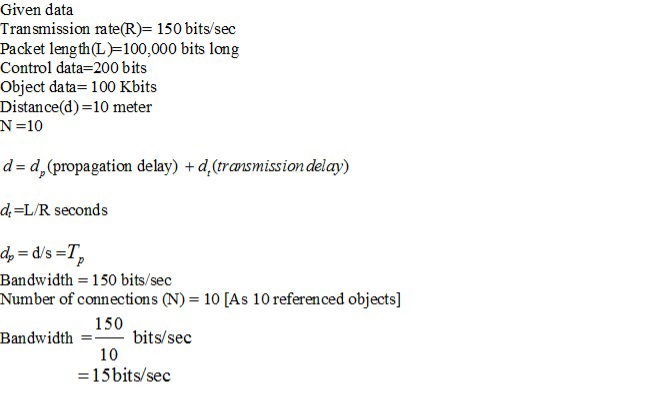Consider a short, 10-meter link, over which a sender can transmit at a rate of 150 bits/sec in both directions. Suppose that packets containing data are 100,000 bits long, and packets containing only control (e.g., ACK or handshaking) are 200 bits long. Assume that N parallel connections each get 1/N of the link bandwidth. Now consider the HTTP protocol, and suppose that each downloaded object is 100 Kbits long, and that the initial downloaded object contains 10 referenced objects from the same sender. Would parallel downloads via parallel instances of non-persistent HTTP make sense in this case? Now consider persistent HTTP. Do you expect significant gains over the non-persistent case? Justify and explain your answer
Consider a short, 10-meter link, over which a sender can transmit at a rate
of 150 bits/sec in both directions. Suppose that packets containing data
are 100,000 bits long, and packets containing only control (e.g., ACK or
handshaking) are 200 bits long. Assume that N parallel connections each
get 1/N of the link bandwidth. Now consider the HTTP protocol, and suppose
that each downloaded object is 100 Kbits long, and that the initial downloaded
object contains 10 referenced objects from the same sender. Would parallel
downloads via parallel instances of non-persistent HTTP make sense in this
case? Now consider persistent HTTP. Do you expect significant gains over
the non-persistent case? Justify and explain your answer

total time for all received objects is given by:
(200/150+Tp + 200/150 +Tp + 200/150+Tp + 100,000/150+ Tp )
+ (200/(150/10)+Tp + 200/(150/10) +Tp + 200/(150/10)+Tp + 100,000/(150/10)+ Tp )
= 7377 + 8*Tp (seconds)
Then consider persistent HTTP connection. The total time needed is give by:
(200/150+Tp + 200/150 +Tp + 200/150+Tp + 100,000/150+ Tp )
+ 10*(200/150+Tp + 100,000/150+ Tp )
=7351 + 24*Tp (seconds)
Assume that propagation the speed of light/mediam is 300*106 m/sec, then Tp=10/(300*106)=0.03 microsec.
here Tp is negligible compared with the transmission delay.
Trending now
This is a popular solution!
Step by step
Solved in 2 steps with 1 images









